display MITSUBISHI OUTLANDER PHEV 2014 Owner's Manual (in English)
[x] Cancel search | Manufacturer: MITSUBISHI, Model Year: 2014, Model line: OUTLANDER PHEV, Model: MITSUBISHI OUTLANDER PHEV 2014Pages: 442, PDF Size: 19.04 MB
Page 243 of 442
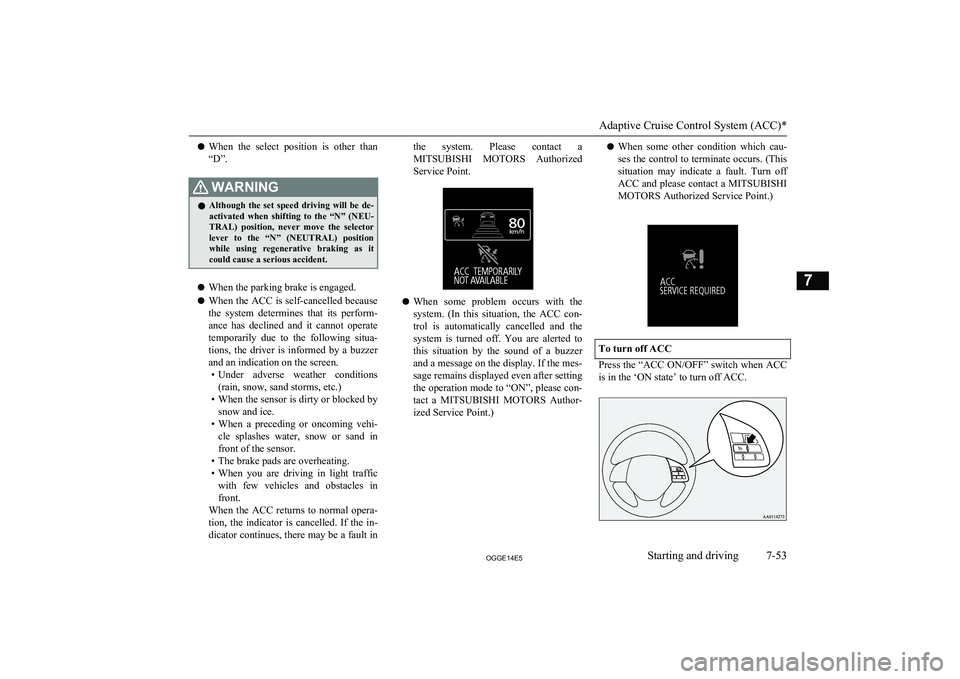
lWhen the select position is other than
“D”.WARNINGl Although the set speed driving will be de-
activated when shifting to the “N” (NEU- TRAL) position, never move the selector lever to the “N” (NEUTRAL) position
while using regenerative braking as it
could cause a serious accident.
l When the parking brake is engaged.
l When the ACC is self-cancelled because
the system determines that its perform- ance has declined and it cannot operate
temporarily due to the following situa- tions, the driver is informed by a buzzer
and an indication on the screen. • Under adverse weather conditions
(rain, snow, sand storms, etc.)
• When the sensor is dirty or blocked by
snow and ice.
• When a preceding or oncoming vehi-
cle splashes water, snow or sand in front of the sensor.
• The brake pads are overheating.
• When you are driving in light traffic
with few vehicles and obstacles in front.
When the ACC returns to normal opera-
tion, the indicator is cancelled. If the in- dicator continues, there may be a fault in
the system. Please contact a
MITSUBISHI MOTORS Authorized
Service Point.
l When some problem occurs with the
system. (In this situation, the ACC con-
trol is automatically cancelled and the system is turned off. You are alerted to
this situation by the sound of a buzzer and a message on the display. If the mes-
sage remains displayed even after setting the operation mode to “ON”, please con-
tact a MITSUBISHI MOTORS Author-
ized Service Point.)
l When some other condition which cau-
ses the control to terminate occurs. (This situation may indicate a fault. Turn off
ACC and please contact a MITSUBISHI
MOTORS Authorized Service Point.)
To turn off ACC
Press the “ACC ON/OFF” switch when ACC is in the ‘ON state’ to turn off ACC.
Adaptive Cruise Control System (ACC)*
7-53OGGE14E5Starting and driving7
Page 244 of 442
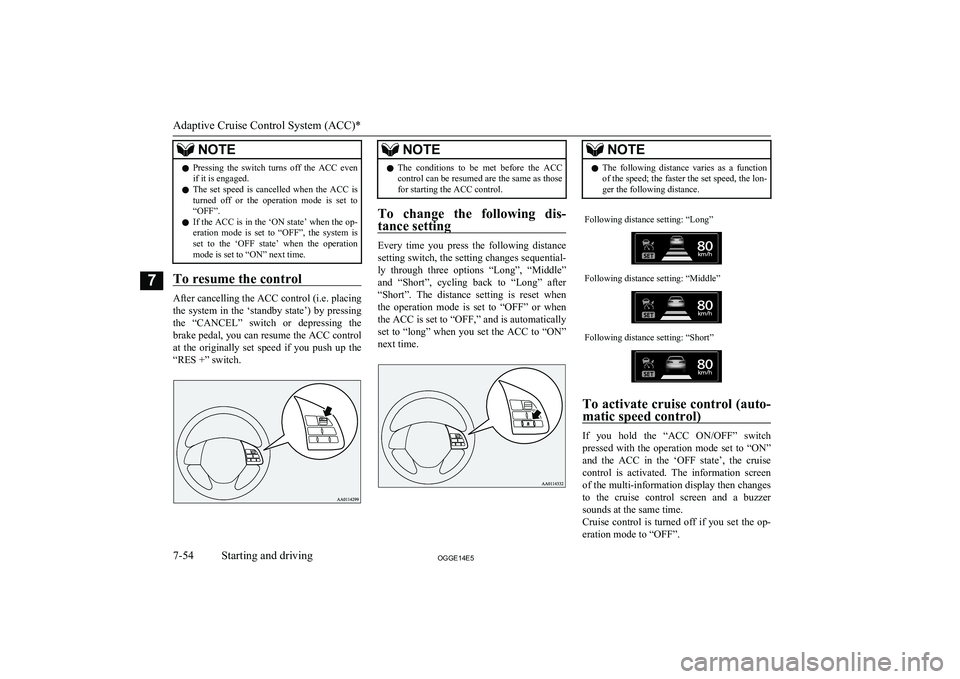
NOTElPressing the switch turns off the ACC even
if it is engaged.
l The set speed is cancelled when the ACC is
turned off or the operation mode is set to
“OFF”.
l If the ACC is in the ‘ON state’ when the op-
eration mode is set to “OFF”, the system is set to the ‘OFF state’ when the operation
mode is set to “ON” next time.
To resume the control
After cancelling the ACC control (i.e. placing
the system in the ‘standby state’) by pressing the “CANCEL” switch or depressing the
brake pedal, you can resume the ACC control
at the originally set speed if you push up the “RES +” switch.
NOTEl The conditions to be met before the ACC
control can be resumed are the same as those for starting the ACC control.
To change the following dis-
tance setting
Every time you press the following distance
setting switch, the setting changes sequential- ly through three options “Long”, “Middle”
and “Short”, cycling back to “Long” after “Short”. The distance setting is reset when
the operation mode is set to “OFF” or when the ACC is set to “OFF,” and is automatically
set to “long” when you set the ACC to “ON”
next time.
NOTEl The following distance varies as a function
of the speed; the faster the set speed, the lon- ger the following distance.Following distance setting: “Long”Following distance setting: “Middle”Following distance setting: “Short”
To activate cruise control (auto-
matic speed control)
If you hold the “ACC ON/OFF” switch
pressed with the operation mode set to “ON” and the ACC in the ‘OFF state’, the cruisecontrol is activated. The information screen
of the multi-information display then changes to the cruise control screen and a buzzersounds at the same time.
Cruise control is turned off if you set the op-
eration mode to “OFF”.
Adaptive Cruise Control System (ACC)*
7-54OGGE14E5Starting and driving7
Page 246 of 442
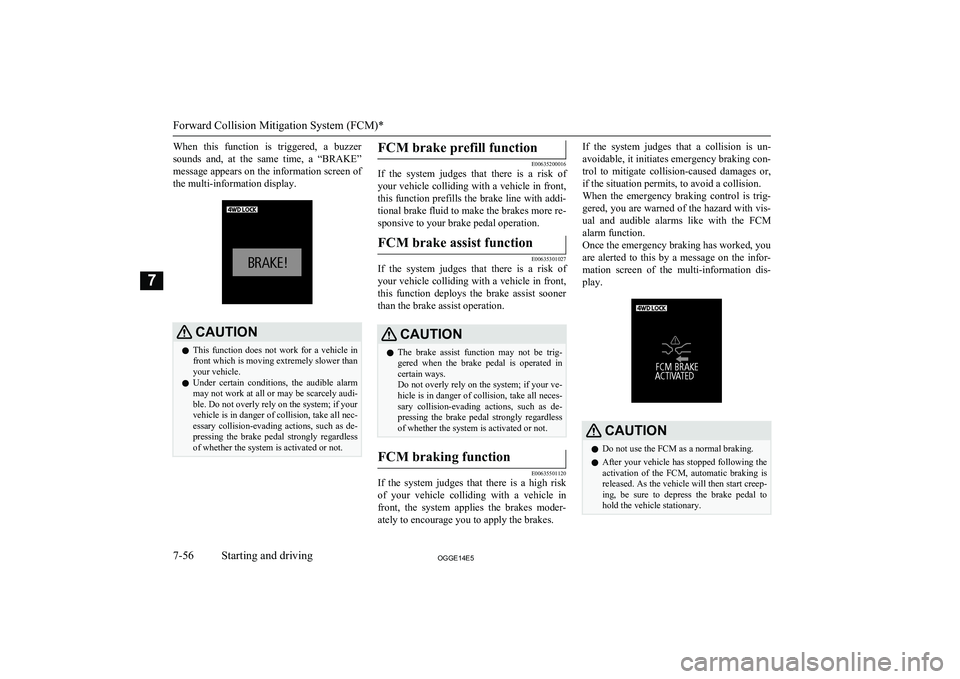
When this function is triggered, a buzzer
sounds and, at the same time, a “BRAKE” message appears on the information screen of
the multi-information display.CAUTIONl This function does not work for a vehicle in
front which is moving extremely slower than
your vehicle.
l Under certain conditions, the audible alarm
may not work at all or may be scarcely audi-
ble. Do not overly rely on the system; if your
vehicle is in danger of collision, take all nec- essary collision-evading actions, such as de-
pressing the brake pedal strongly regardless of whether the system is activated or not.FCM brake prefill function
E00635200016
If the system judges that there is a risk of
your vehicle colliding with a vehicle in front,
this function prefills the brake line with addi- tional brake fluid to make the brakes more re-
sponsive to your brake pedal operation.
FCM brake assist function
E00635301027
If the system judges that there is a risk of your vehicle colliding with a vehicle in front,
this function deploys the brake assist sooner than the brake assist operation.
CAUTIONl The brake assist function may not be trig-
gered when the brake pedal is operated in certain ways.
Do not overly rely on the system; if your ve-
hicle is in danger of collision, take all neces-
sary collision-evading actions, such as de-
pressing the brake pedal strongly regardless of whether the system is activated or not.FCM braking function
E00635501120
If the system judges that there is a high risk
of your vehicle colliding with a vehicle in
front, the system applies the brakes moder-
ately to encourage you to apply the brakes.
If the system judges that a collision is un-
avoidable, it initiates emergency braking con-trol to mitigate collision-caused damages or,
if the situation permits, to avoid a collision.
When the emergency braking control is trig- gered, you are warned of the hazard with vis-
ual and audible alarms like with the FCM
alarm function.
Once the emergency braking has worked, you
are alerted to this by a message on the infor- mation screen of the multi-information dis- play.CAUTIONl Do not use the FCM as a normal braking.
l After your vehicle has stopped following the
activation of the FCM, automatic braking is
released. As the vehicle will then start creep-
ing, be sure to depress the brake pedal to
hold the vehicle stationary.
Forward Collision Mitigation System (FCM)*
7-56OGGE14E5Starting and driving7
Page 247 of 442
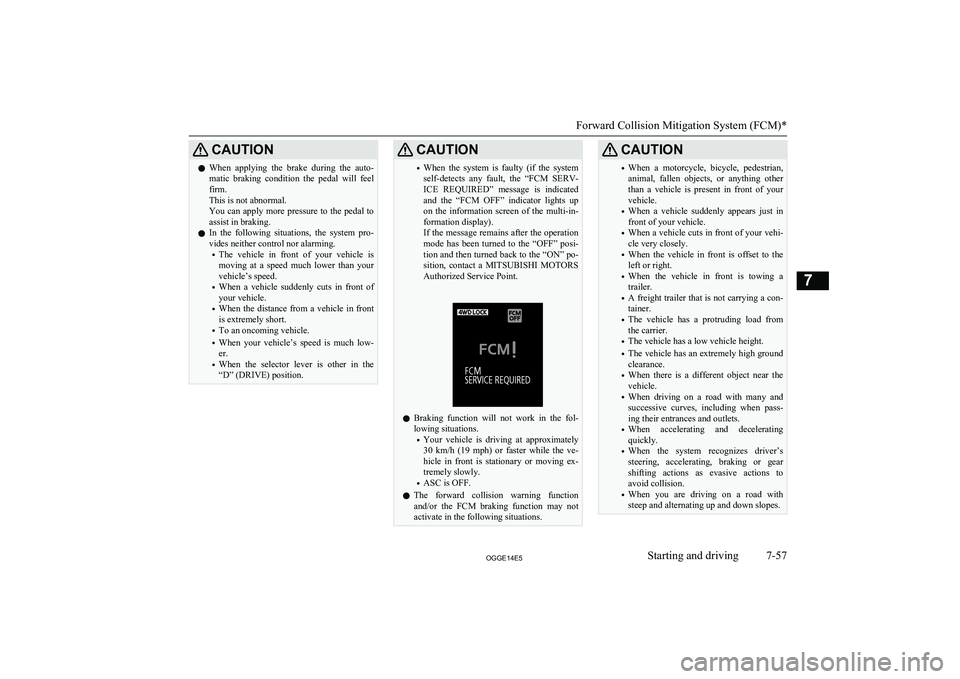
CAUTIONlWhen applying the brake during the auto-
matic braking condition the pedal will feel firm.
This is not abnormal.
You can apply more pressure to the pedal to
assist in braking.
l In the following situations, the system pro-
vides neither control nor alarming.
• The vehicle in front of your vehicle is
moving at a speed much lower than your
vehicle’s speed.
• When a vehicle suddenly cuts in front of
your vehicle.
• When the distance from a vehicle in front
is extremely short.
• To an oncoming vehicle.
• When your vehicle’s speed is much low-
er.
• When the selector lever is other in the
“D” (DRIVE) position.CAUTION• When the system is faulty (if the system
self-detects any fault, the “FCM SERV- ICE REQUIRED” message is indicated
and the “FCM OFF” indicator lights up on the information screen of the multi-in- formation display).
If the message remains after the operation
mode has been turned to the “OFF” posi- tion and then turned back to the “ON” po-
sition, contact a MITSUBISHI MOTORS
Authorized Service Point.
l Braking function will not work in the fol-
lowing situations.
• Your vehicle is driving at approximately
30 km/h (19 mph) or faster while the ve-
hicle in front is stationary or moving ex-
tremely slowly.
• ASC is OFF.
l The forward collision warning function
and/or the FCM braking function may not
activate in the following situations.
CAUTION• When a motorcycle, bicycle, pedestrian,
animal, fallen objects, or anything other
than a vehicle is present in front of your vehicle.
• When a vehicle suddenly appears just in
front of your vehicle.
• When a vehicle cuts in front of your vehi-
cle very closely.
• When the vehicle in front is offset to the
left or right.
• When the vehicle in front is towing a
trailer.
• A freight trailer that is not carrying a con-
tainer.
• The vehicle has a protruding load from
the carrier.
• The vehicle has a low vehicle height.
• The vehicle has an extremely high ground
clearance.
• When there is a different object near the
vehicle.
• When driving on a road with many and
successive curves, including when pass-
ing their entrances and outlets.
• When accelerating and decelerating
quickly.
• When the system recognizes driver’s
steering, accelerating, braking or gear
shifting actions as evasive actions to
avoid collision.
• When you are driving on a road with
steep and alternating up and down slopes.
Forward Collision Mitigation System (FCM)*
7-57OGGE14E5Starting and driving7
Page 250 of 442

When the switch is held pressed, theON/OFF state of the FCM changes from ON
to OFF and vice versa. If you give the switch
a short press with FCM in the ON state, you can change the collision alarm timing.
To turn on/off the system
You can switch the system from OFF to ONor ON to OFF if you hold the FCM ON/OFF
switch pressed when the operation mode is set to “ON”.
Once the system is turned on, a buzzer sounds, the information screen of the multi-
information display shows the collision alarm
timing currently selected, and the “FCM OFF” indicator on the screen goes out.
When you turn off the system, a buzzer
sound and, at the same time, the “FCM OFF”message appears on the screen and the “FCM
OFF” indicator comes on.
Switching the operation mode to ON will set
the FCM back ON.
To change alarm timing
Give a short press to the FCM ON/OFFswitch to change the timing at which the
frontal collision alarm is triggered. Every time you press the switch, the alarm timingchanges alternately between “FAR” (earlier
alarming) and “NEAR” (later alarming).
As you make a selection, the selected alarm timing is displayed on the information screen
of the multi-information display. Even after turning off FCM or setting the operationmode to “OFF”, the system retains your last
selected alarm timing in memory.
When “NEAR” is selectedWhen “FAR” is selectedCAUTIONl For the FCM brake prefill, the FCM brake
assist and the FCM braking functions, the function triggering timing cannot be changed.
Forward Collision Mitigation System (FCM)*
7-60OGGE14E5Starting and driving7
Page 251 of 442
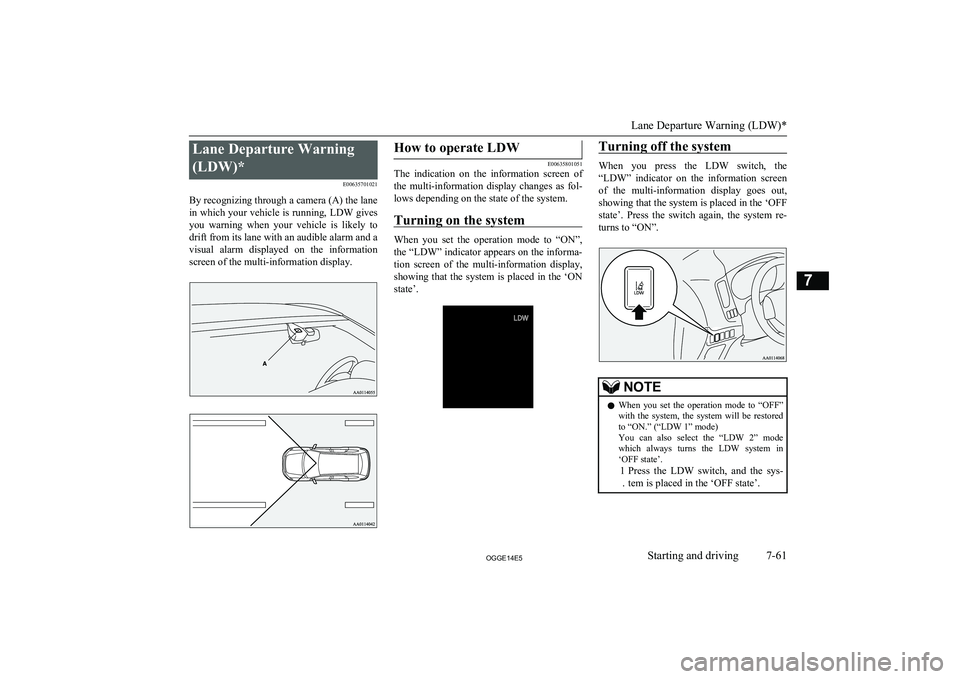
Lane Departure Warning(LDW)* E00635701021
By recognizing through a camera (A) the lane
in which your vehicle is running, LDW gives you warning when your vehicle is likely to drift from its lane with an audible alarm and a
visual alarm displayed on the information
screen of the multi-information display.How to operate LDW
E00635801051
The indication on the information screen of
the multi-information display changes as fol-lows depending on the state of the system.
Turning on the system
When you set the operation mode to “ON”,
the “LDW” indicator appears on the informa- tion screen of the multi-information display, showing that the system is placed in the ‘ON
state’.
Turning off the system
When you press the LDW switch, the
“LDW” indicator on the information screen of the multi-information display goes out,
showing that the system is placed in the ‘OFF state’. Press the switch again, the system re-
turns to “ON”.
NOTEl When you set the operation mode to “OFF”
with the system, the system will be restored
to “ON.” (“LDW 1” mode)
You can also select the “LDW 2” mode
which always turns the LDW system in ‘OFF state’.
1
. Press the LDW switch, and the sys-
tem is placed in the ‘OFF state’.
Lane Departure Warning (LDW)*
7-61OGGE14E5Starting and driving7
Page 252 of 442
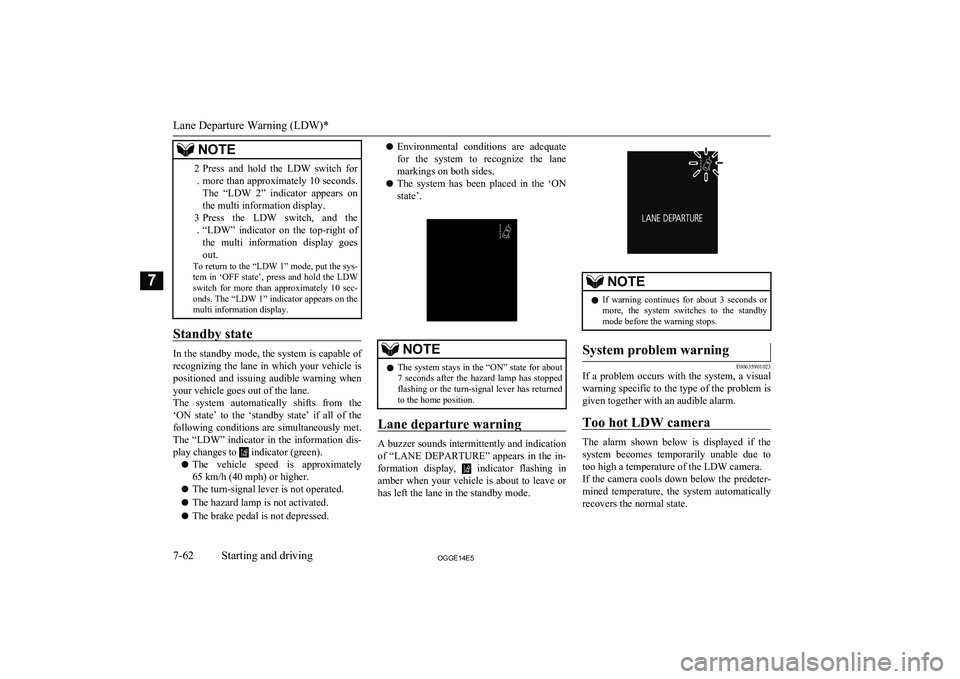
NOTE2. Press and hold the LDW switch for
more than approximately 10 seconds. The “LDW 2” indicator appears on
the multi information display.
3 . Press the LDW switch, and the
“LDW” indicator on the top-right of the multi information display goes out.
To return to the “LDW 1” mode, put the sys-
tem in ‘OFF state’, press and hold the LDW switch for more than approximately 10 sec-onds. The “LDW 1” indicator appears on the
multi information display.
Standby state
In the standby mode, the system is capable of
recognizing the lane in which your vehicle is positioned and issuing audible warning whenyour vehicle goes out of the lane.
The system automatically shifts from the
‘ON state’ to the ‘standby state’ if all of the following conditions are simultaneously met.
The “LDW” indicator in the information dis-
play changes to
indicator (green).
l The vehicle speed is approximately
65 km/h (40 mph) or higher.
l The turn-signal lever is not operated.
l The hazard lamp is not activated.
l The brake pedal is not depressed.
lEnvironmental conditions are adequate
for the system to recognize the lane markings on both sides.
l The system has been placed in the ‘ON
state’.NOTEl The system stays in the “ON” state for about
7 seconds after the hazard lamp has stopped
flashing or the turn-signal lever has returned to the home position.
Lane departure warning
A buzzer sounds intermittently and indication
of “LANE DEPARTURE” appears in the in-
formation display,
indicator flashing in
amber when your vehicle is about to leave or has left the lane in the standby mode.
NOTEl If warning continues for about 3 seconds or
more, the system switches to the standby
mode before the warning stops.System problem warning
E00635901023
If a problem occurs with the system, a visual
warning specific to the type of the problem isgiven together with an audible alarm.
Too hot LDW camera
The alarm shown below is displayed if the system becomes temporarily unable due totoo high a temperature of the LDW camera.If the camera cools down below the predeter-
mined temperature, the system automatically
recovers the normal state.
Lane Departure Warning (LDW)*
7-62OGGE14E5Starting and driving7
Page 253 of 442

NOTElThe warning message can be cleared tempo-
rarily by setting the LDW switch to “OFF.”
LDW deactivation due to fault
The alarm shown below is displayed if LDW
becomes to a non-initialized state due to a
fault.
If this happens, please contact a
MITSUBISHI MOTORS Authorized Service
Point for inspection of the system.
CAUTIONl LDW has its performance limitations. Do
not over-rely on the system.
l LDW is not designed to lessen risks associ-
ated with not looking ahead carefully (atten-
tion drawn to something on the side, absent-
mindedness, etc.) or poor visibility caused
by bad weather etc. Keep steering your vehi-
cle correctly and drive safely.
l The system may not be able to detect the
lane correctly in the following conditions. If required, set the LDW switch to “OFF.”
• When driving on a road whose lane mark-
ings (white or yellow) are worn out or
smeared with dirt to an extent not recog- nizable by the system.
• When lane markings are vague, typically
during a drive in the rain, snow or fog, or when running against the sun.
• When the vehicle is moving in a place
where lane markings are interrupted, such
as a toll booth entrance and motorway junction.
• When running on a road portion with in-
completely removed old lane markings,
shadows, lingering snow, truck-like pud- dles mistakable for lane markings (espe-cially after the rain when road surface is
reflecting light) or similar confusing fac- tors.
• When running in a lane other than the
cruising lane and passing lane.
• When running beside a closed lane sec-
tion or in a provisional lane in a traffic
work zone.CAUTION• When running in an extremely narrow
lane.
• When the following distance between
your vehicle and a vehicle in front be-
comes extremely reduced (especially when a marking is hidden by a vehicle in
front this is running too close to the mark- ing).
• When entering a junction or other point of
road where lanes are laid out complicated-ly.
• When passing a road section where the
number of lanes increases/decreases or
multiple lanes are crossing each other.
• When the lane is marked by double or
otherwise special lines.
• When driving on a winding or rough road.
• When driving on a slippery road covered
by rain water, snow, ice, etc.
• When passing through a place where the
brightness suddenly changes, like the inlet or outlet of a tunnel.
• When turning steep curves.
• When the road surface is reflecting the
light shining from the direction opposite
to the running direction.
• Vehicle largely lurches when it is running
over steps or other irregularities of the
road surface.
• When the headlamp illumination is inade-
quate because of contaminated or deterio-
rated lenses or improperly aimed head- lamps.
Lane Departure Warning (LDW)*
7-63OGGE14E5Starting and driving7
Page 254 of 442

CAUTION•When the vehicle is leaning much to one
side due to heavy luggage on it or improp-
erly adjusted tyre pressures.
• When oncoming vehicles’ headlamps
shine the LDW camera.
• When the vehicle is equipped with non-
standard tyres (including excessively
worn tyres), is using a snow traction de-
vice (tyre chains), or has non-specified
components such as a modified suspen- sion.
• When the windscreen is covered with rain
water, snow, dust, etc.
l Follow the instructions given below to keep
your LDW in good operating conditions.
• Always keep the windscreen clean.
• Avoid applying a strong shock or pressure
to the LDW camera. Do not attempt to
disassemble it.
• Disturbing the installation of the LDW
camera or its removal is under no circum- stances permitted. The camera has been
precisely oriented at the factory.
• Do not put anything like a sticker on the
area in front of the LDW camera lens of the windscreen.
• Use only
MITSUBISHI MOTORS GEN-
UINE Parts when replacing the wind-
screen wipers.Tyre pressure monitoring
system (TPMS) E00637100110
The tyre pressure monitoring system (TPMS)
uses tyre inflation pressure sensors (A) on the wheels to monitor the tyre inflation pressures.
The system only indicates when a tyre is sig-
nificantly under-inflated.
The base tyre pressure can be set at desired value by the driver with the reset function ex-
ecution. (The low pressure warning threshold is set based on the reset.)
The tyre inflation pressure sensor IDs for two sets of tyres can be registered by aMITSUBISHI MOTORS Authorized Service
Point, and the valid ID set can be switched by the multi-information display switch. (It’s
beneficial in case of seasonal tyre change be-
tween summer tyre and winter tyre.)NOTEl The tyre pressure monitoring system
(TPMS) is not a substitute for regularlychecking tyre inflation pressures.
Be sure to check the tyre inflation pressures as described in “Tyres” on page 11-10.
l The tyre inflation pressure sensor (B) is in-
stalled in the illustrated location.
Replace grommet and washer (C) with a
new one when the tyre is replaced.
For details, please contact your
MITSUBISHI MOTORS Authorized Serv-
ice Point.Tyre pressure monitoring sys-
tem warning lamp/display
E00637200078Tyre pressure monitoring system (TPMS)
7-64OGGE14E5Starting and driving7
Page 255 of 442

When the operation mode is put in ON, the
tyre pressure monitoring system warning
lamp normally illuminates and goes off a few seconds later.
If one or more of the vehicle tyres is signifi-
cantly under-inflated, the warning lamp will remain illuminated while the operation modeis in ON.
Refer to “If the warning lamp/display illumi-
nates while driving” on page 7-66 and take
the necessary measures.NOTEl In addition, the warning display will be dis-
played on the information screen in the mul-
ti-information display.CAUTIONl If the warning lamp does not illuminate
when the operation mode is put in ON, it
means that the tyre pressure monitoring sys- tem (TPMS) is not working properly. Have
the system inspected by a MITSUBISHI
MOTORS Authorized Service Point.
In such situations, a malfunctioning of the system may be preventing the monitoring of the tyre pressure. Avoid sudden braking,
sharp turning and high-speed driving.
l If a malfunction is detected in the tyre pres-
sure monitoring system (TPMS), the warn-
ing lamp will blink for approximately 1 mi- nute and then remain continuously illumina-
ted. The warning lamp will issue further
warnings each time the Plug-in Hybrid EV
System is restarted as long as the malfunc- tion exists.
Check to see whether the warning lamp goes
off after few minutes driving.
If it then goes off during driving, there is no
problem.
However, if the warning lamp does not go off, or if it blinks again when the Plug-in
Hybrid EV System is restarted, have the ve- hicle inspected by a MITSUBISHI
MOTORS Authorized Service Point.
In such situations, a malfunctioning of the system may be preventing the monitoring of the tyre pressure. For safety reasons, when
the warning lamp appears while driving,
avoid sudden braking, sharp turning and high-speed driving.NOTEl In addition, the warning display will be dis-
played on the information screen in the mul-
ti-information display.
Each tyre, including the spare (if so equip-
ped), should be checked monthly when cold and inflated to the inflation pressure recom-
mended by the vehicle manufacturer on the tyre inflation pressure label. (If your vehiclehas tyres of a different size than the size indi-
cated on the tyre inflation pressure label, you should determine the proper tyre inflationpressure for those tyres.)
As an added safety feature, your vehicle has
been equipped with the tyre pressure moni- toring system (TPMS) that illuminates a low
tyre pressure telltale when one or more of
your tyres is significantly under-inflated.
Accordingly, when the low tyre pressure tell- tale illuminates, you should stop and checkyour tyres as soon as possible, and inflate
them to the proper pressure. Driving on a sig- nificantly under-inflated tyre causes the tyre
to overheat and can lead to tyre failure.
Tyre pressure monitoring system (TPMS)
7-65OGGE14E5Starting and driving7